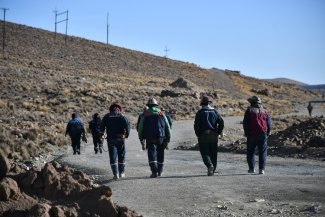

There are a number of countries that have earned plaudits internationally for saving hundreds of thousands of lives with their swift, effective and decisive responses to the coronavirus – Taiwan, Vietnam, Ghana, Senegal and South Korea amongst them. But in India, the southern state of Kerala has implemented a world-leading strategy to tackle the worst pandemic in nearly 100 years.
Despite having a population of around 35 million people, as of 28 May, there were only 526 COVID-positive cases receiving treatment and there have been just seven deaths from COVID-19 in Kerala out of 4,531 across the whole of India. By comparison, the UK, which has a population of approximately 67 million people, has the second highest death toll in the world with over 35,000 deaths.
It could have been very different: with more than a million foreign tourists a year, hundreds of its students studying in China, four million internal migrant workers living in the state and up to a sixth of its population working abroad (mainly in the Gulf), Kerala could have been devastated by the virus. But the communist-run state took forceful measures to ‘flatten the curve’ early on. Kerala’s health minister KK Shailaja convened an emergency COVID-19 meeting on 24 January, just three days after learning about the outbreak of the novel virus in China. Comprehensive guidelines were published just two days later, and rapid response teams were formed in districts across the state, involving everyone from trade unions to students to civil society, and plans of action were formulated on everything from surveillance to testing to mental health provisions.
By the time the first case of coronavirus landed in Kerala on 27 January, the state government had already activated controls at airports and train stations to detect the entry of the virus into the state, and it had established temporary quarantine shelters to house tourists and non-residents. These steps were followed by aggressive testing, contact tracing, a community surveillance system, compulsory social distancing measures, long quarantine periods, hand washing stations set up in public places, and a strict lockdown that was made bearable thanks to the home delivery of groceries and cooked meals for those most in need, in addition to the provision of food and shelter for some of the migrant workers who could not return home.
Kerala was home to the world’s first democratically elected communist government. In 1957 the Indian Communist Party won the state elections, since then power has alternated between two left-wing coalitions. That Kerala was able to recognise the threat posed by the coronavirus and respond to it so quickly is a legacy of decades of progressive politics and an egalitarian development strategy – known as the ‘Kerala model’ – that has resulted in the highest literacy rate in India, the highest life expectancy, the lowest infant mortality rate and a primary health care centre in every village. Kerala is also home to Kudumbashree, the world’s largest women’s empowerment project. It is currently helping nearly five million women climb out of poverty, and during the corona crisis it has produced millions of units of masks and hand sanitisers, as well as operating community kitchens across the state.
Kerala’s ability to react effectively to the health emergency is also thanks to the lessons learned in the wake of the 2018 Nipah outbreak, a virus even deadlier than COVID-19 for which there is still no treatment or vaccine available. The outbreak shook the state’s normally robust health system and left 17 people dead in a month. As a result, the government implemented various measures and protocols – such as contact tracing – which paved the way for Kerala’s impressive response to the current pandemic.
Although Kerala has managed to flatten the curve, and the transmission of the coronavirus is limited at the moment, like the rest of India, it is suffering from the socio-economic consequences of the lockdown. Some measures have already been relaxed so that economic activities can resume, but the state remains vigilant, setting up protocols to prevent a spike in infections due to the return of thousands of migrant workers stranded abroad or in other Indian states. What happens next is anyone’s guess, but it is clear that, thanks to the social policies that Kerala has implemented over the last fifty years, it is in a strong position to weather whatever storm may come.

Two volunteers carry out a passenger check at Ernakulam Junction railway station, the biggest train station in the city of Kochi in Kerala, before the suspension of railway services on 23 March. The passenger’s personal information is recorded, their temperature is taken and they are asked about their latest movements and the state of their health.
These measures are part of the state government’s community surveillance programme, which enables contact tracing of anyone who has been in close proximity to someone infected with the coronavirus. Such people have to self-isolate at home for 28 days and are contacted by phone twice a day to check up on their symptoms. If any of the quarantined patients report any symptoms, they are presumed to be positive and transferred to medical isolation centres before being tested. If their results are negative, they can return home. If they test positive, the cycle begins again, with contact tracers identifying all their contacts from the 14 days prior to symptoms; those people are then quarantined and monitored by phone at home.

This hand washing stations, located in Fort Kochi on 21 March, is one of many set up across the state under the slogan ‘Break the Chain’.
On 16 March, Kerala’s health minister KK Shailaja launched a campaign titled ‘Break the Chain’ in order to sensitise the public about the importance of public and personal hygiene in the wake of the COVID-19 outbreak. Water taps and soap dispensers were installed in public spaces such as bus stops, railway stations and markets along with posters informing people of the correct way to wash their hands. The state also began to produce hand sanitiser which it is selling at subsidised prices. And people were summoned to practice social distancing and wear reusable face masks in public; failure to do so can result in a 200 rupee fine (US$2.65).

A sign at a guesthouse in Fort Kochi, one of the main tourist attractions in Kerala, announces its temporary closure due to coronavirus.
In 2019, Kerala received 1.96 million tourists, a rise of almost 17.2 per cent since 1996, but this year, numbers are expected to plummet with industry bodies recording millions of dollars in lost revenue so far. Although it does not expect to recover the number of international tourists originally projected for 2020, Kerala may pivot to focus on domestic tourists, with discounts on hotel rooms and a push towards adventure tourism, which lends itself towards social distancing.

An autorickshaw driver in front of Ernakulam North railway station protects his face with a mask. Since the lockdown was announced on 23 March, local and migrant workers have been able to receive state aid to mitigate the impact of forced confinement.
Shocking images of tens of thousands of daily wage earners fleeing large cities across India to return home once the lockdown was announced to avoid facing starvation has been one of the defining stories of this global pandemic. An estimated 470 million internal migrants in India have been trapped far from their homes and without any income to survive. But in Kerala these scenes of despair have been widely avoided thanks to the state government’s provision of food, shelter and access to medical care to otherwise destitute migrant workers. Things are far from perfect, however. According to a 2017 investigation by First Post, there are three million migrant workers in Kerala, 60 per cent of which work in the construction sector, and many of whom live in cramped labour camps where sanitation is absent and social distancing is impossible. But during this period of confinement significant attempts were made to provide basic services to those who most need it.

A man sells fish on a market stall in the Ernakulam district of Kochi, Kerala.
During the lockdown shops and stalls selling food were one of the few services that were allowed to remain open. The deserted streets full of closed shops during the strict first weeks of the lockdown are begin to recover their activity: public transport is operating with 50 per cent seating capacity; barbers, hairdressers and beauty salons are allowed to open without the use of air conditioning; and shopping complexes have now reopened with 50 per cent of shops to open on a rotational basis. But at all times, members of the public must wear face coverings and take the proper precautions to ensure safe social distancing.

An employee at the Fort Kochi ferry terminal tells customers on 21 March that transportation services have been suspended.
Ferry services resumed on May 20 after nearly two months of lockdown after the COVID-19 outbreak. Boats are operating from 7am to 7pm without a permanent schedule, and occupancy has been cut in half to ensure compliance with physical distancing norms. The ferry is mostly used by local people from Fort Kochi and Mattanchery who work in shops and offices in the city.










